This is not the first time that we’ve pointed and laughed at San Francisco, not even close. They’ve seen famous and influential retailers pull out due to crime going unpunished. Their solution has been to give trannies universal basic income.
It’s so bad that plenty of traditional propaganda rags, even so-called “left-wing” ones have condemned the city. Financial Times gets in on the action, starting off with a story about a ten month old child accidentally ingesting fentanyl and almost dying. After setting the stage with that, they go into the titanic wealth divide in San Fran.
But San Francisco’s problems go far beyond drugs. The Bay Area is home to four of the 10 most valuable companies in the world — Apple, Alphabet, Nvidia and Meta — titanic producers of wealth, but a staggering one per cent of the city’s population is homeless, compared with less than 0.2 per cent across the US. The gulf between rich and poor — and white and black — is among the largest in America. House prices and rents soared to among the highest in the US during the last tech boom. Since the pandemic, tech companies have embraced remote working, laid off staff and slashed office space, leaving almost a third of the city’s commercial real estate vacant. In other words, houses are more expensive and scarcer, and offices are cheap and empty. Teachers and nurses can’t afford to live in San Francisco, and tech workers see fewer reasons to.
I’ve given up on predicting with any certainty the way the winds will blow, but I’ve long felt that San Francisco is the new Detroit. It won’t quite die. Instead, it’ll remain a dystopian shithole, with some extremely nice parts in sight of druggies breathing their last. Impressively, this was done without a Seasoning-American problem. Because when life gives you an all-White or Asian city, ZOG makes sure to get everyone addicted to fentanyl so it turns into a shithole anyway.

The city recently saw Bob Lee, some tech entrepreneur, get stabbed to death. However, there were some reports that claim that might not have been a homeless man, and instead some other “entrepreneur.” In any case, it’s a violent shithole, with human feces strewn about everywhere.
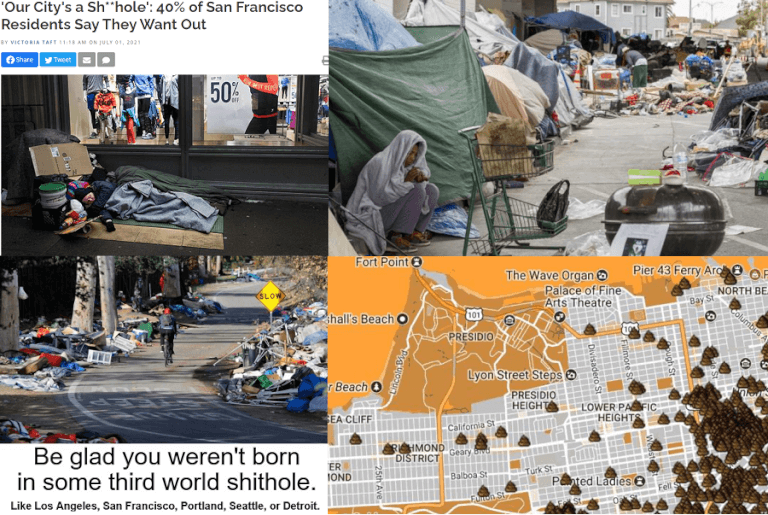
Vancouver is a similar city. The DTES is the closest thing to hell that you’ll ever see. However, there are some extremely nice areas, and the rent is astronomical. That’s the way our parasite class likes it. It’s not just about them having nice stuff, it’s about you not having nice stuff, or even basic safety.
The privileged class doesn’t take the subway, and they think it’s hilarious that you have to deal with this when you do, peasant.
The fog is lying low over the Tenderloin one Saturday morning in April, as Adisa begins his daily patrol. He is six-feet tall, with a diamond stud in his nose, and is wearing a T-shirt that reads “No Fuckery”, the motto of his employer, Urban Alchemy. The non-profit, founded in San Francisco in 2018, has received tens of millions of dollars in contracts from the city to “turn around” downtown streets. The service it provides is maybe best described as a for-hire neighbourhood watch. Its employees, in a uniform of dark-green army camouflage jackets, walk the streets, acting like an auxiliary police force. Adisa says Urban Alchemy has reversed 1,300 opioid overdoses in the two years he has worked there. He once had to give naloxone to a dog that had licked fentanyl off the sidewalk.
The Tenderloin, a neighbourhood just south-west of touristy Union Square, is home to some 35,000 people in fewer than 50 cramped blocks. Drugs and destitution are out in the open. Sticks of burning incense have been jammed into the shutters of closed businesses to mask the smell of human excrement. Glass from shattered car windows glitters in the gutter. A few people are hunched over in wheelchairs, clutching the paraphernalia of hard drug use. Urban Alchemy has around 45 people on the ground here at any given time.
It’s the Downtown East Side in Vancouver. Once you’ve seen one of these apocalyptic shitholes you’ve seen them all.
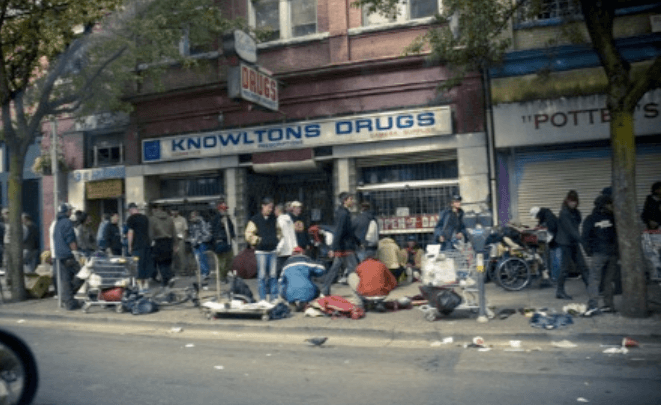
The city’s solution to people openly doing drugs is not to arrest them, give them treatment, or what have you. The solution is to spend tens of millions of taxpayer dollars on a “non-profit,” that attempts to diminish the symptoms of the problem, but never the cause.
Urban Alchemy’s mission isn’t to move people, Adisa says, but to clean up the areas where it operates, turning up at 7am every day where people are sleeping on the street, collecting their trash, bringing coffee, chatting. Some of the homeless end up in shelters this way; others are guided to nearby churches or charities to get clothes or food. In some cases, Urban Alchemy employees do physically move people: loitering shoplifters, drug users near schools, people relieving themselves in public.
The solution to the human excrement everywhere problem is to chat with the literal street shitters. Yes that’s right. To chat with them.
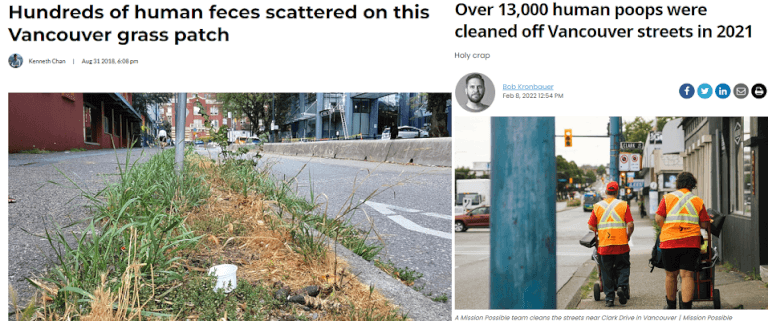
The butthole-left is so truly awful that it makes it difficult to continue with the narrative that the consubversives are just as bad. There is a certain brand of utter lunatic antifa types, recently recalled San Fran DA (((Chessa Boudin))) among them, who are purely malicious and evil characters who should be hung from the nearest streetlamp. They’ll tell you that they’re anti-war, and fighting super hard against billionaires. Give them any hint of power, and the best they can do is coddle people literally shitting on your sidewalk.
But she faces the confluence of problems that has plunged San Francisco, especially downtown, into uncertainty and chaos. It has been the slowest city in the US to recover from the pandemic; mobile phone activity in the downtown area is still only a third of 2019 levels, a sign of tourism’s decline and tech companies’ retreat. “We’re trying to adjust, we have to adjust,” Breed says. San Francisco has a “young workforce that is not shopping and not going downtown”, which has intensified hotspots like the Tenderloin and “Soma” — South of Market Street — for drugs and outdoor sleeping, she says. “We have got to get control over open-air drug dealing and behavioural health challenges if people are going to feel safe coming to San Francisco.”
One third of the mobile phone use as pre-pandemic, a very good proxy for the total amount of people there. Although the crime is so bad that there might be proportionally less mobile phone use per person, because you’ve got to keep you head on a swivel when you’re surrounded by human feces landmines and unstable drug addicts.
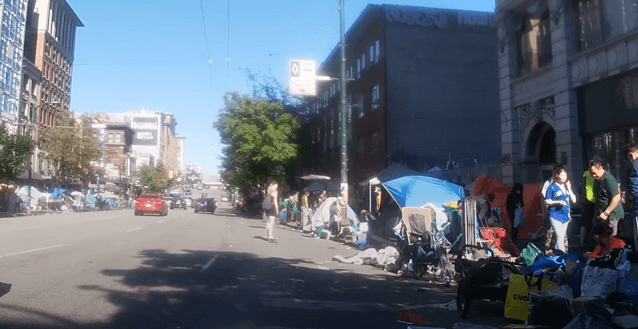
The above is from Vancouver, but it’s the same thing.
It is a striking downturn for downtown. In the late 1980s, the luxury department store Nordstrom made an unusual bet on an area once considered skid row, opening on Market Street and ushering in a wave of redevelopment. This month, more than 30 years on, the retailer announced it is abandoning the city entirely, with its landlord blaming “rampant criminal activity” for making operating too costly and too dangerous. Down the street, Whole Foods — the Amazon-owned grocery chain symbolic of upper middle-class aspiration — closed its flagship shop a few weeks earlier, citing worker safety. In just over a year, staff made almost 600 emergency calls about violent shoplifters and overdoses.
I covered the retail abandonment before, but the numbers are staggering. Six hundred calls in about two hundred days. That’s three calls per day about overdoses or violent shoplifting, also called “living in hell”.

And of course, it isn’t just Nordstrom.
The area has lost a net of 2,500 businesses since March 2020. Now residents are doubtful about the long-delayed opening of San Francisco’s first Ikea just three blocks away from Whole Foods — although Ikea said its plans had not changed. “So many stores shuttered in downtown SF. Feels post-apocalyptic,” Elon Musk wrote earlier this month on Twitter, whose headquarters are practically next door to the shuttered Whole Foods and were once part of the would-be downtown turnaround.
It’s so bad that even Elon Musk can’t miss the mark.

Tech companies were among the most enthusiastic in embracing remote work during the pandemic, banking a tax saving and allowing employees to avoid San Francisco’s high rents. The reduction in demand has only been compounded by tech lay-offs. “The irony for the city is that the economy that grew up as a response to the measures we adopted in 2009 to pull us out of the recession focused on a single industry,” says Wade Rose, the president of Advance SF, which lobbies on behalf of the city’s business community. “Then the pandemic hits, and it turns out that the economic sector we had built up was the most amenable to switching where their employees worked from.”
And the employees don’t want to work from here.
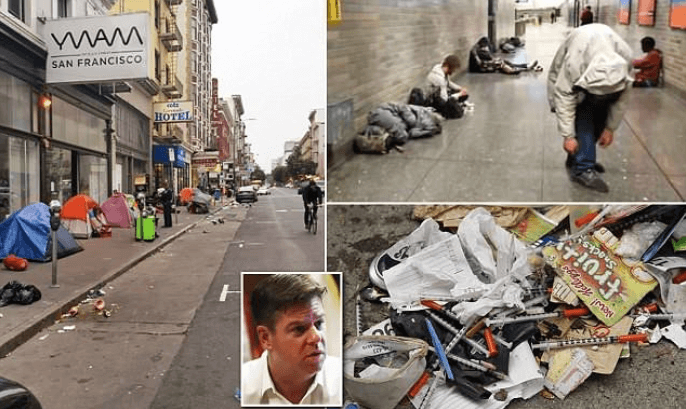
Work from home is an interesting proposition. On one hand, big businesses are natural monopolies, and capitalism is rigged. From that perspective, these tech companies can force their workers to come in anyway. On the other hand, there is literally no benefit from the workers perspective to risking the stab happy drug addicts of colour on the subway and enjoying the smell of the fresh air laden with human feces. And that’s in addition to the one hour each way time cost of the trip.
It will be interesting to see what eventually wins out. (((Blackrock))) demanding that employees stop work from home, or employees using their individual power to avoid doing that. Normally I’d predict Total Jew Capital Victory, but there are so many workers who will just quit and try finding other jobs if forced to run the human feces gauntlet of downtown San Fran that I’m really not sure what will happen.
It’s a shame. San Francisco is a naturally beautiful area. But the problem is that they just don’t have the budget to –
San Francisco’s city budget this year is $14bn — almost twice the budget for the entire state of New Hampshire — for about 810,000 residents. Breed says she will spend an extra $600mn — equivalent to the city’s entire annual homeless budget — to cut the number of unsheltered people in half by the end of 2028 by prioritising building permanent supportive housing over temporary shelters. (Urban Alchemy’s more than $40mn of contracts with the city also involve running private shelters.) Part of the problem is that these shelters can be full of empty beds as people in the grip of powerful addiction are lured back to the streets for easy access to their next hit.
Just kidding. The city is obscenely wealthy, due to the tech companies and natural beauty driving the real estate costs up. The leadership can’t be bothered to clean up the streets, even though it’s as simple and cheap as “arrest the druggies doing drugs right in front of you.” But don’t worry, they’ve got the Drag Laureate position filled, so their priorities are in check.
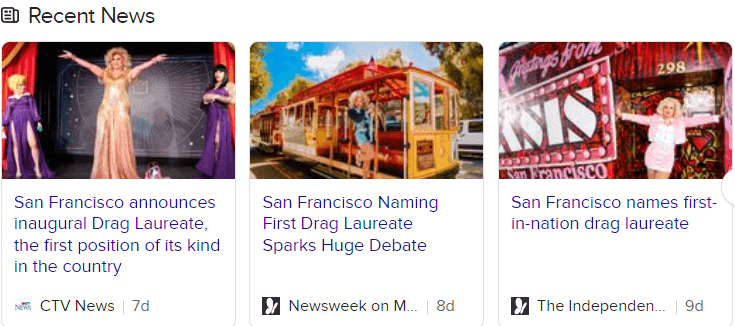
There were a few interesting comments underneath the piece. Some were delusional San Fran shitlibs. Most were like this one from Merasheen:
I have always loved visiting San Francisco (first trip 30+ years ago) but have no inclination now. My last visit was in March 2020 just on the cusp of everything closing down; made even more memorable as I was at a conference with 700+ attendees, staying at the Hyatt Embarcadero. Heading out to get a coffee at Peet’s, mints at CVS or riding the BART out to Berkeley – truly felt like I was in a war zone. And I have travelled extensively solo to many complicated corners of the world. Here’s hoping the iron analogy is correct.
Commenter implausible:
The problem is not “sensationalized crime” but day to day, even boring crime. Human poop on streets, stores either looted by mobs or slowly emptied by shop lifters. Fentanyl openly sold by local reps of the cartels. Well past “broken windows” neighborhoods face murder, burglary, assault and arson.
Commenter Daniel21
The San Francisco decay stories are not a Fox News fantasy. My sister has lived in SF for 40 years. She will confirm everything that the writer says in the article. She is a liberal, but is incredulous at the way the city leaders have let the place unravel. Wealthy people may be able to stay out of harm’s way, or simply be able to be voyeurs of the decay during commutes to work or a baseball game, but everyone else has to deal daily with anti-social and aggressive homeless people and drug addicts even in what were once neat and tidy middle class neighborhoods. There is Fentanyl everywhere – literally: a few years ago a little boy nearly died after ingesting some he came upon in a park – and human excrement abounds on the pavement. None of the fans of the city send their kids to its public schools.
It reminds me of the people who push for open borders, but live in gated communities.
Commenter SF Nurse,
I’m a nurse at a SF hospital – the same addicts are admitted every 2 weeks, know exactly what to say, do and to what they are entitled …they come to SF because they get tons of services and can do their drugs…it often feels like they have more rights than someone like me, who pays taxes, owns my home (worked hard for decades to do so) . “Homeless advocacy” “nonprofits” will attack any efforts for residents of the city to for example remove tent encampments from the block on which I live. The reality is most homeless in SF decline shelters because they aren’t allowed to do drugs there. They should not be primarily referred to as homeless, but drug addicts…their advocates bid for “harm reduction” which means they enable them to do their drugs and get narcan, no obligation! Until the politicians realize that what’s left of the tax base in SF is working people who are in great need of “harm reduction” i.e. from the tyranny of degradation, squalor, illegal activity and violence that has been enabled in the name of “liberalism” the workers will continue to leave. Spewing statistics about relative crime rates does not convince the person who lives here.
Commenter Jeeryjb,
Difficult to understand. I plan to attend a conference in San Francisco in the fall. It occurs there every four years and I wonder what I’ll find on the streets this time. Last time downtown was filled with homeless people. Prices were extremely high. No one outside the tech industry can afford the necessities- food, etc. I have to keep reminding myself that San Francisco isn’t the real everyday America. Interestingly, I was in Mexico City in March for a different meeting. I saw no homeless there. A few people perhaps offering window cleaning services while at a traffic stop. I walked the streets freely. It’s just strange to see such poverty in a first world country in a city- San Francisco that leads the world in tech. Totally upside down.
One last quote from the original piece.
How does the “doom loop” theoretically play out? Remote workers never come back, driving down the value of office space and leading to the shuttering of more businesses. Political infighting among progressive politicians continues, keeping the city from making concerted progress on the homelessness, violence, drug use. The city’s tax base shrinks further, exacerbating a projected $780mn budget deficit over the next two fiscal years and withering vital public services. Then, in 2024, a Republican wins the US presidential election and, unable to resist the political boon of bashing the country’s most iconic liberal city when it’s down, finds ways to make a turnaround even harder. In this scenario, San Francisco becomes the new Detroit, a town remembered for what it used to be.
Ignoring the Finklethink, that’s an interesting take. Many people point to San Fran’s natural beauty as something that will prevent it from going the way of Detroit, but that’s something I’m highly skeptical of.
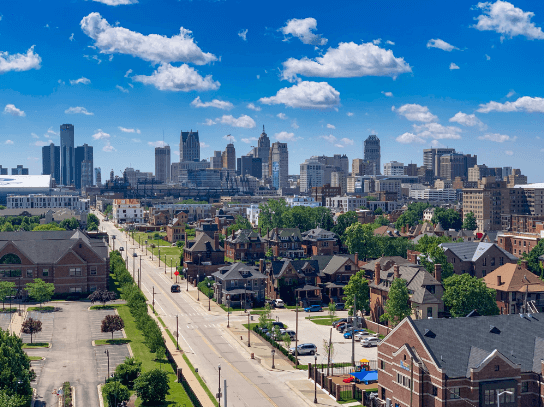
After all, the above picture is not San Francisco, but Detroit, Michigan. As is the picture below.
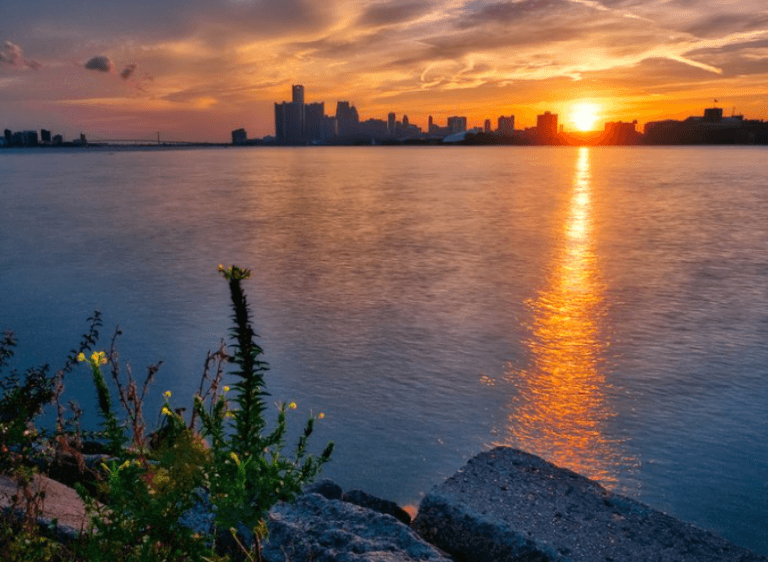
Detroit is a city with plenty of natural beauty. It’s been ruined by DemocratPolicy-Americans, and won’t be resuscitated until the demographics improve, irrespective of the natural beauty. Even then, there are some nice areas of Detroit that you can live in, provided you have enough money.
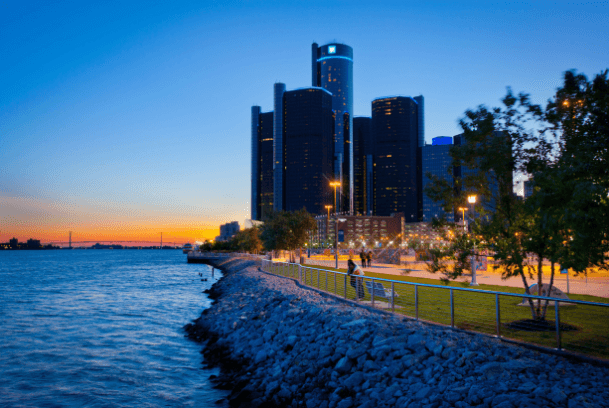
Detroit, Michigan.
As a trucker I would occasionally deliver to Oakland and San Fran. I used to get out of the truck and do a brief run at the end of the day. In Oakland I started to do that, before getting right back inside. San Fran wasn’t much better, with visible shantytowns everywhere. As bad as Canada is, even in Vancouver it’s hard to see that kind of squalour and ultra wealth right next to each other.
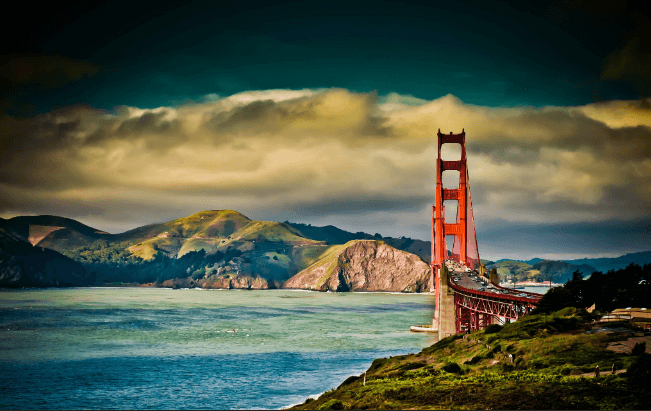
The reason I find San Fran so important is not because “Muh DEMONrats.” It’s because it’s a city that could be absolutely gorgeous and wonderful, and it’s an unlivable shithole for anyone not in the top 1%. As the residents desperately demand people enforce the law, the leadership boasts about giving trannies UBI, and creating a new position called the “Drag Queen Laureate.”
 San Francisco is the future that the (((Democracy Class))) wants for us all. Tons of pervert garbage everywhere. Mass wealth inequality. Human feces on the streets. All ruled over by hedge funds and trillion dollar multinationals.
San Francisco is the future that the (((Democracy Class))) wants for us all. Tons of pervert garbage everywhere. Mass wealth inequality. Human feces on the streets. All ruled over by hedge funds and trillion dollar multinationals.

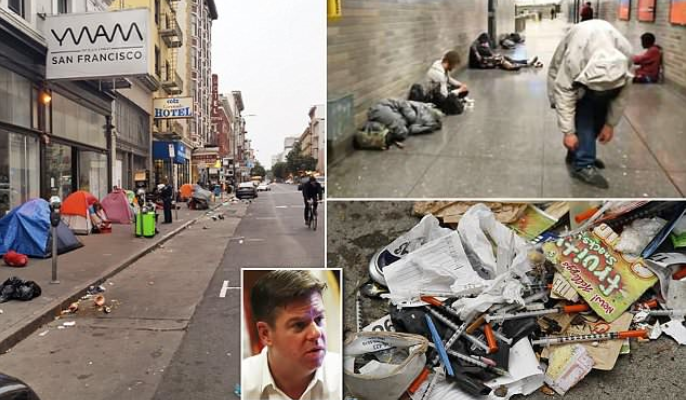

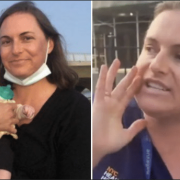




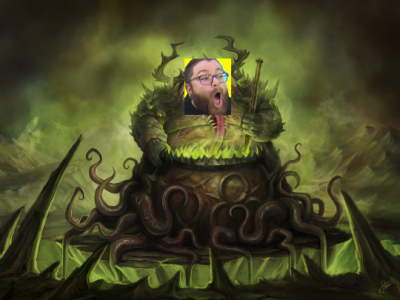


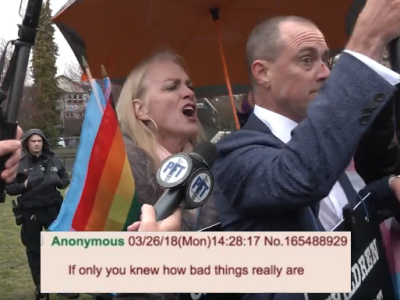

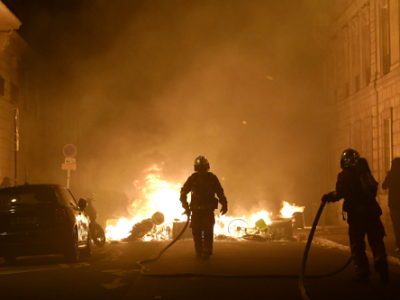


The homeless are demonic. They love their addictions, revel in their squalor, and are totally beholden to the 1% for their continued existence . Their purpose is to torment mere mortals, deface beauty, and in so doing, humiliate Whites.
So, of course, they get total institutional and financial support (to the tune of $600M/year in San Fran).
I’m surprised the (((tech entrepreneur class))) haven’t built a private elevated enclosed walk-way and shop network in downtown San Francisco (using public funds, of course), 30 feet above the India-style shitting streets they created.
It’s what would happen in every awful libertarian futurist novel these people seem to use as a game plan.
>titanic producers of wealth
Meta (renamed parent/holding company of Facebook) does not ‘produce wealth’ in any traditional sense of that phrase — its platforms are a vehicle for advertising. Alphabet (Google) is also fundamentally a service company, but they do produce/offer a wider variety of services, and produce a lot of SW, Android being just one example. Apple and Nvidia can genuinely called more traditional ‘producers of wealth’.
>The gulf between rich and poor — and white and black — is among the largest in America.
This is true of California generally, and is in large part (but not entirely) a product of immigration — over the preceding decades, California has seen a mass influx of literally millions of low IQ mestizos — the HS graduation rate of the LAUSD (the largest school district in the US) was at one time barely 50% — it has increased over the last 20 years or so, but that is in part due to lowered standards.
https://www.ppic.org/publication/income-inequality-in-california/
“The gap between high- and low-income families in California is among the largest in the nation—exceeding all but three other states in 2021 (the latest data available). … California’s income distribution reflects high rates of poverty. …”
In a very expensive place like SF, this gap will be greatly accentuated as the middle class is driven/priced out, while the poor, who depend directly on public assistance or indirect subsidies (they are not net producers of wealth), are squeezed into deteriorating neighborhoods that are also increasingly non-white.
The decline of SF has been fairly rapid, and is related to a shrinking middle class — I spent some time there in late 80s and early 90s because I had friends and work colleagues who lived in the Haight (Haight-Ashbury).
>it has increased over the last 20 years or so, but that is in part due to lowered standards.
Here is an infographic showing the rising HS graduation rate in LA (currently over 80%):
http://www.trbimg.com/img-57b32e2c/turbine/la-me-edu-l-a-unified-projects-best-graduation-rates-ever-20160816/600
If you go back some years before 2009-10 (62%), the rate was only around 50%.
I don’t think those mestizos have gotten any smarter — so thru a variety of ruses, including lowering standards, they have managed to raise the rate to something more respectable.
When you project this throughout the state, you have a LOT of dumb people who can only get menial employment. Combined with declining union membership rates, that means they are poor.
Los Angeles Unified
https://caaspp.edsource.org/sbac/los-angeles-unified-19647330000000
“See below for the California Smarter Balanced results for tests which were taken by students in the spring of 2022, and reported by EdSource. … In the overall Los Angeles Unified test results for 2022, 41.7% of students met or exceeded the state standard in English, while 58.29% did not, a change of -2.2% from 2019. In math, 28.49% of students met or exceeded the state standard, with 71.51% not meeting it: a change of -4.98% from 2019.”
Even if you use the 2019 results, it’s clear a sizable majority of LAUSD students do not meet the ‘state standard’ in literacy (‘English’) or math — and those standards are already minimal, probably about the level of the average 6th grader at a private/parochial school.
One can ask: how can a school district consistently raise its graduation rate when a sizable majority of its students do not meet minimal standards?
California has the lowest literacy rate of any state, data suggests
https://edsource.org/updates/california-has-the-lowest-literacy-rate-of-any-state-data-suggests
Los Angeles is fairly consistently rated the least literate city in the US.
OT
This story is an apt metaphor for Western civilization:
“Raub mit Messern – aber Sympathisanten solidarisieren sich mit Tätern!”
https://www.bz-berlin.de/berlin/treptow-koepenick/raub-mit-messern-aber-sympathisanten-solidarisieren-sich-mit-taetern
There was a robbery in a Berlin park — the victims, who were threatened with a knife, called the cops who showed up quickly, so quickly they managed to catch the robbers nearby — look at the top foto: the African in handcuffs is obviously one of those arrested for robbery (the other person arrested was very probably black too, but he’s not seen in the foto) — so much for the ‘Raub mit Messern’ part of the metaphor: black criminals in a white country.
Now for the ‘Sympathisanten solidarisieren sich mit Tätern!’ — people who witnessed the arrest verbally protested to the cops about it — they started to shout at the cops and film the arrest (as if the cops were doing something wrong ) — judging by the other fotos, those who expressed sympathy for the African criminals were Germans (white, or ‘Bioudeutsch’).
Today it’s the same story writ large, i.e. on a societal scale, everywhere in the West.
“Many people point to San Fran’s natural beauty as something that will prevent it from going the way of Detroit, but that’s something I’m highly skeptical of. ”
And you’re right to be skeptical. You should never underestimate the jew’s ability to take the beautiful and the divine and twist it into the ugly and evil.
In Detroit and environs there was a large legacy population of Blacks, many of whom migrated from the South in the decades after the Civil War to work in factories, later factories building cars and supplying parts to the automobile industry — once those jobs vanished, the rot began, and white flight sealed the fate of Detroit.
There is no such large legacy population of Blacks in San Francisco, and it’s far too expensive for them to move there now.
https://www.census.gov/quickfacts/sanfranciscocitycalifornia
Barely 5% of SF’s population is black, compared to approx 13.5% in the US generally (as a state, the fraction of Blacks in California is also less than half the national value). Blacks in SF are mostly confined to a few small areas that no one cares about or visits anyway, like Bayview-Hunters Point.
Too much old and new money in SF — a kind of Armageddon due to already high and rising commercial real estate vacancy rates is a much greater threat, e.g. to the city’s finances. The degradation of civic life via homelessness, drug abuse, shoplifting, etc is likely one reason for that, but in truth it’s more a factor that has helped worsen a trend that already existed.
If the city got rid of the derelicts who congregate downtown, and high vacancy rates drops rents for office space, you’ll see some sort of revival in SF — as a location it’s too attractive, and with Caltrain and BART there are ways for people to fairly conveniently commute to/from the city (it’ll probably remain an expensive place to live).